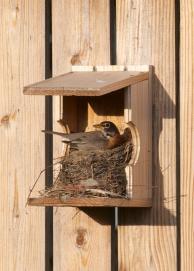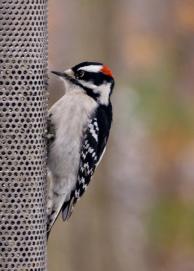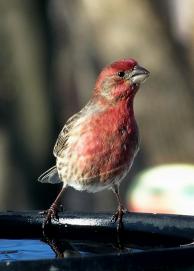White-breasted Nuthatch
 I was filling my feeder when out of the corner of my eye I caught a flash of blue. The nuthatch was back again. This time picking up pieces of peanuts. I couldn’t help but be amazed at his unique ability of walking along the limb upside down. With its long toes and strong claws, he appears to defy gravity.
I was filling my feeder when out of the corner of my eye I caught a flash of blue. The nuthatch was back again. This time picking up pieces of peanuts. I couldn’t help but be amazed at his unique ability of walking along the limb upside down. With its long toes and strong claws, he appears to defy gravity.
In the distance, I could hear his repetitious nasal “Yank” call. It sounds a bit like laughter. The male sports a dark black cap on a slate blue back. His white belly matches the spots on each side of his short tale.
He offers food to his mate as an act of pair bonding. Spring is coming and courting begins again. Last year he dropped chunks of bark into the knot hole to prepare the nest cavity. Ant bodies were smeared all around the entrance. This helps to make the nest hole less appealing to squirrels in search of their own nest cavity. Who wants to live with ants climbing all over the place? Grasses, rootlets and fur will support five to eight lightly spotted white eggs. A two week incubation period begins after the final egg is laid. Upon hatching, the mate feeding ends and many trips back to the nest with insects and larva are made by both parents.
The surrounding area of mixed mature hardwoods with scattered standing dead trees is ideal habitat for these birds. Mostly an insect eater, suet, seeds and nuts have to do in winter. Pairs may spend 7 to 10 years in the same area.
Recently a customer called about a smaller nuthatch with a black eye stripe and reddish breast. Could this be the female? What she described was a Red-breasted Nuthatch. Not present every winter, red-breasteds will wander out of Canada and northern United States in years of poor pine seed production. Their slimmer bills work great for extracting seeds from pinecones while their larger, white-breasted cousin uses its heaver bill to crack seeds and nuts, thus the name Nuthatch.
By John Burwell
Mark's Spotlight
-

American Gold Finch
Read more about the American Goldfinch -

American Robin
Read more about the American Robin -

Black-Capped Chickadee
Read more about the Black-Capped Chickadee -

Downy Woodpecker
Read more about the Downy Woodpecker -

House Finch (Male)
Read more about House Finch -

Northern Cardinal
Read More about Northern Cardinal
Shop Now!
-
Mark's No-Waste Blend™
Regular price From $15.99 USDRegular price -
Boardwalk Blend™
Regular price From $8.99 USDRegular price -
NP1009 OrioleFest
Regular price $29.99 USDRegular price -
Multi-Seed Tube Feeders w/Quick-Clean® Bases
Regular price From $59.99 USDRegular price











